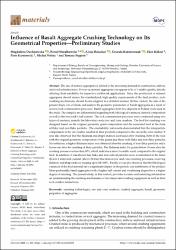| dc.contributor.author | Duchnowska, Magdalena | |
| dc.contributor.author | Strzałkowski, Paweł | |
| dc.contributor.author | Bakalarz, Alicja | |
| dc.contributor.author | Kaźmierczak, Urszula | |
| dc.contributor.author | Köken, Ekin | |
| dc.contributor.author | Karwowski, Piotr | |
| dc.contributor.author | Wolny, Michał | |
| dc.contributor.author | Stępień, Tomasz | |
| dc.date.accessioned | 2024-04-19T13:40:12Z | |
| dc.date.available | 2024-04-19T13:40:12Z | |
| dc.date.issued | 2023 | en_US |
| dc.identifier.issn | 1996-1944 | |
| dc.identifier.uri | https://doi.org/10.3390/ma16020602 | |
| dc.identifier.uri | https://hdl.handle.net/20.500.12573/2111 | |
| dc.description.abstract | The use of mineral aggregates is related to the increasing demand in construction, railway and road infrastructures. However, mineral aggregates can appear to be of variable quality, directly affecting their suitability for respective earthwork applications. Since the production of mineral aggregates should ensure the standardized, high-quality requirements of the final product, rock-crushing mechanisms should be investigated in a detailed manner. In this context, the aim of the present study is to evaluate and analyze the geometric parameters of basalt aggregates as a result of several rock comminution processes. Basalt aggregates from two deposits in Poland were used in the study. The samples are differentiated regarding both lithological variances, mineral composition as well as the host rock’s tuff content. The rock comminution processes were conducted using two types of crushers, namely the laboratory-scale jaw and cone crushers. The feed for crushing was designed based on the original geometric grain composition and the separated feed in the form of flaky and non-flaky particles. The crushability test results demonstrated that the interparticle compression in the jaw crusher resulted in finer products compared to the one in the cone crusher. It was also observed that the flakiness and shape indexes decreased after crushing, both in the feed with the original geometric composition of the grains and those with flaky and non-flaky particles. Nevertheless, a higher flakiness index was obtained after the crushing of non-flaky particles and a lower one after the crushing of flaky particles. The flakiness index for grains below 16 mm after the crushing process was less than 10%, which indicates a more favorable result compared to the original feed. In addition, it was shown that flaky and non-cubical particles were accumulated in the finest (below 8 mm) and coarsest (above 20 mm) fractions in jaw and cone crushing processes, receiving flakiness and shape indexes ranging up to 80–100%. Finally, it was also observed that the lithological variances of the feed material have a significant impact on the particle size distribution of the product. More profoundly, basalt aggregates with a higher tuff content and weathering degree have a higher degree of crushing. The present study, in this context, provides accurate and satisfying information on understanding the crushing mechanisms of two important crushing equipment as well as their rock-crusher interactions. | en_US |
| dc.description.sponsorship | This research was funded by THE POLISH MINISTRY OF EDUCATION AND SCIENCE SUBSIDY 2022 for the Department of Mining WUST, grant number 8211104160.
The authors wish to express their gratefulness to the aggregate mining plants from the region of Lower Silesia for the material provided for the tests. | en_US |
| dc.language.iso | eng | en_US |
| dc.publisher | MDPI | en_US |
| dc.relation.isversionof | 10.3390/ma16020602 | en_US |
| dc.rights | info:eu-repo/semantics/openAccess | en_US |
| dc.subject | crushing technologies | en_US |
| dc.subject | jaw and cone crushers | en_US |
| dc.subject | crushed aggregate | en_US |
| dc.subject | basalt | en_US |
| dc.subject | geometric properties of aggregates | en_US |
| dc.title | Influence of Basalt Aggregate Crushing Technology on Its Geometrical Properties—Preliminary Studies | en_US |
| dc.type | article | en_US |
| dc.contributor.department | AGÜ, Mühendislik Fakültesi, Malzeme Bilimi ve Nanoteknoloji Mühendisliği Bölümü | en_US |
| dc.contributor.authorID | 0000-0003-0178-329X | en_US |
| dc.contributor.institutionauthor | Köken, Ekin | |
| dc.identifier.volume | 16 | en_US |
| dc.identifier.issue | 2 | en_US |
| dc.identifier.startpage | 1 | en_US |
| dc.identifier.endpage | 22 | en_US |
| dc.relation.journal | Materials | en_US |
| dc.relation.publicationcategory | Makale - Uluslararası Hakemli Dergi - Kurum Öğretim Elemanı | en_US |


















